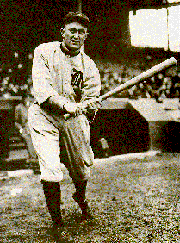Do Professional Players use Heavy or Light Bats?
By:
|
The answer to that question is "both," though past players tend to have used heavier bats than do today's players. Baseball's "king of swat" Babe Ruth reportedly began his hitting career using a 54 ounce (1.5 kg) hickory bat, and is known to have used a 40oz bat in 1927 when he hit his 60 home runs.[1] Ty Cobb and Joe Di Maggio both played with 42oz bats and Rogers Hornsby used a 50oz piece of lumber. George Sisler, playing for the St. Louis Browns in the 1920's, made his bat heavier by hammering Victrola needles into the barrel of his bat.[2] In the 1950's Cincinnati Reds' Ted Kluszeski hammered tenpenny nails into his bat to make it heavier. Other great hitters including Ted Williams, Rod Carew and Stan Musial used much lighter bats: 31-33oz.[1] Roger Maris used a 33oz bat to hit his 61 home runs in 1961. Many players have tried to make their bats lighter by drilling a hole in the barrel and filling it with cork. Detroit Tigers' Norm Cash admitted to using a corked bat in 1961 when he won the batting title with a .361 average (though he slumped to .243 the next year with the same corked bat).[2] Kirkpatrick[3] reports that Roger Maris participated in a 1962 experiment in which he batted for distance with 5 different new bats whose weights varied from 33 to 47oz. He hit 5 long fly balls with each bat and the distances were measured and correlated to bat weight. The heavier bats, on average, resulted in further distance. However, Maris' preferred bat (which he used to break Babe Ruth's home run record) was the lightest of the set, even though it produced the shortest distance fly balls. Mark McGwire used a 35oz bat to hit his 70 home runs in 1998, and Barry Bonds used a 32oz bat to hit his 73 home runs in 2001. Most of today's major league players typically use 31-35oz bats. Physicists have shown,[3,4] from a simple collision analysis, that the optimum bat weight is between 15 and 18oz. However, no professional batter uses a bat this light (in fact, you cannot make a wood bat this light). NCAA regulations[x] recently imposed a -3 rule (length in inches minus weigh in ounces cannot exceed 3) so that 34 inch bats must weigh 31oz. So far no such rule exists for Little League play, and -12 composite bats were introduced for the 2003 season. This brings us back to our original questions: which is better: heavier or lighter bats? So, what is the optimum bat weight, and what criteria influence this choice? Let's start by looking at the collision between ball and bat. |
|

Chris Temple
Elliot Kennel